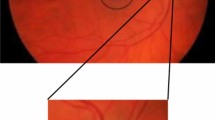Abstract
Our sensory organs make us more confident and dependable. Glaucoma which causes damage to the optic nerves is “the sneak thief of sight” as there are no symptoms, and once the vision is lost, then it is permanent. The data from the Glaucoma Research Foundation states that over 60 million people worldwide are affected by glaucoma. This is one of the leading causes of irreversible blindness. Hence, it is very important to detect glaucoma and treat it well at its early stage itself. Electroretinography is one of the methods which can show the status of the cells present in the retina of the eye. Increase in intraocular pressure is a significant information by which one can suspect whether the person has chances for the occurrence of glaucoma or not. Tonometry is used to detect the intraocular pressure. The increase in the pressure has adverse effect on optic disc and optic nerves. Further, using retinal fundus image and applying image processing techniques on that, one can analyse the episode of upcoming eye disorder. The processing of the image includes the preprocessing techniques and segmentation techniques. The active contour method is one of the reliable methods. These procedures can help the population to deal with glaucoma at its early stage itself such that they can get rid of the unwanted blindness.
Access this chapter
Tax calculation will be finalised at checkout
Purchases are for personal use only
Similar content being viewed by others
References
Madhusudhan M, Malay N, Nirmala SR, Samerendra D (2011, July) Image processing techniques for glaucoma detection. In: International conference on advances in computing and communications, vol 6. Springer, Berlin, Heidelberg, pp 365–373
Kumar UR, HL (2015). eyewiki.aao.org. Retrieved from http://eyewiki.aao.org/Electroretinogram
(2019). Retrieved from. moorfields.nhs.uk: https://www.moorfields.nhs.uk/content/anatomy-eye
Swathi C, Anoop BK, Dhas DAS, Sanker SP (2017, March) Comparison of different image preprocessing methods used for retinal fundus images. In Emerging Devices and Smart Systems (ICEDSS), 2017 conference on (pp. 175–179). IEEE.
Bach M, Hawlina M, Holder GE, Marmor M, Meigen T, Vaegan MY (2000) Standard for pattern electroretinography. Doc Ophthalmol 101:11–18
Dawson WW, Trick GL, Litzkow CA (1979) Improved electrode for electroretinography. Invest Ophthalmol Vis Sci 18:988–991
Sieving PA, Steinberg RH (1987) Proximal retinal contributions to the intraretinal 8-Hz pattern ERG of cat. J Neurophysiol 57:104–20
Bach M, Gerling J, Geiger K (1992) Optic atrophy reduces the pattern-electroretinogram for both fine and coarse stimulus patterns. Clin Vision Sci 7:327–333
Zrenner E (1989) Physiological basis of the pattern electroretinogram. Progr Retin Res 9:427–64
Anto Bennet M, Dharini D, Priyadharshini SM (2016) Detection of blood vessel Segmentation in retinal images using Adaptive filters. J Chem Pharma Res 8(4):290–298
Missfeldt, M. (2017). Retrieved from varifocals.net: https://www.varifocals.net/human-eye
Prasath R (2014) Automated drusen grading system in fundus image using fuzzy C-means clustering. Int J Eng Technol 2(6):833
Otto T, Bach M (1997) Re-test variability and diurnal effects in the pattern electroretinogram (PERG). Doc Ophthalmol 92:311–323
Mendonca AM, Campilho A (2006) Segmentation of retinal blood vessels by combining the detection of centerlines and morphological reconstruction. IEEE Trans Med Imaging 25:1200–1213
Youssif AA-HA-R, Ghalwash AZ, Ghoneim AASA-R (2008) Optic disc detection from normalized digital fundus images by means of a vessels’ direction matched filter. IEEE Trans Med Imaging 27:11–18
Bock R, Meier J, Nyúl LG, Hornegger J, Michelson G (2010) Glaucoma risk index: automated glaucoma detection from color fundus images. Med Image Anal 14:471–481
Active contour model. In Wikipedia. Retrieved November 18, 2018, from https://en.wikipedia.org/wiki/Active_contour_model
Fukuda T, Morimoto Y, Morishita S, Tokuyama T (2001) Theory of communication. ACM Trans Database Syst 26(2):179–213
Region growing. In Wikipedia. Retrieved May 3, 2018, from https://en.wikipedia.org/wiki/Region_growing
(2018). WebMD. Retrieved from webmd.com: https://www.webmd.com/eye-health/occular-hypertension
Technology and Accessibility. September 14, 2015, Glaucoma Research Foundation
Author information
Authors and Affiliations
Editor information
Editors and Affiliations
Rights and permissions
Copyright information
© 2019 Springer Nature Singapore Pte Ltd.
About this chapter
Cite this chapter
Jha, S. (2019). Fundamentals of Electroretinogram and Analysis of Retinal Fundus Image. In: Paul, S. (eds) Application of Biomedical Engineering in Neuroscience. Springer, Singapore. https://doi.org/10.1007/978-981-13-7142-4_7
Download citation
DOI: https://doi.org/10.1007/978-981-13-7142-4_7
Published:
Publisher Name: Springer, Singapore
Print ISBN: 978-981-13-7141-7
Online ISBN: 978-981-13-7142-4
eBook Packages: Biomedical and Life SciencesBiomedical and Life Sciences (R0)




